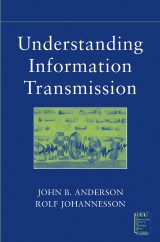Details

Understanding Information Transmission
IEEE Press Understanding Science & Technology Series, Band 18 1. Aufl.
|
72,99 € |
|
| Verlag: | Wiley |
| Format: | |
| Veröffentl.: | 17.02.2006 |
| ISBN/EAN: | 9780471711193 |
| Sprache: | englisch |
| Anzahl Seiten: | 320 |
DRM-geschütztes eBook, Sie benötigen z.B. Adobe Digital Editions und eine Adobe ID zum Lesen.
Beschreibungen
<i>Understanding Information Transmission</i> introduces you to the entire field of information technology. In this consumer handbook and introductory student resource, seven chapters span the gamut of the field—the nature, storage, transmission, networking, and protection of information. In addition to the science and technology, this book brings the subject alive by presenting the amazing history of information technology, profiling incredible inventions and fascinating inventors, and their dramatic impact on society. Features include problem sets, key points, suggested reading, review appendices, and a full chapter on mathematical methods. Private and public funding of information technology continues to grow at staggering rates. Learn what’s behind this race to be the biggest, brightest, and fastest in the field with <i>Understanding Information Transmission</i>.
<p>Preface vii</p> <p><b>1. Introduction: First Ideas and Some History 1</b></p> <p>1.1 What is communication? 2</p> <p>1.2 Why digital communication? 6</p> <p>1.3 Some history 8</p> <p>1.4 A few remarks on intellectual history 27</p> <p>1.5 Conclusions 28</p> <p>References 29</p> <p><b>2. Mathematical Methods of Information Transmission: Why Sinusoids? 30</b></p> <p>2.1 Linear, time-invariant (LTI) systems 31</p> <p>2.2 On the importance of being sinusoidal 43</p> <p>2.3 The Fourier transform 48</p> <p>2.4 What is bandwidth? 58</p> <p>2.5 Discrete-time systems 66</p> <p>2.6 Conclusions 69</p> <p>References 70</p> <p>Problems 70</p> <p><b>3. Information Sources: What is Out There to be Sent? 77</b></p> <p>3.1 What is text? 78</p> <p>3.2 What is speech? 81</p> <p>3.3 What is music? 88</p> <p>3.4 What is an image? 94</p> <p>3.5 What is video? 98</p> <p>3.6 Conclusion 102</p> <p>References 102</p> <p>Problems 103</p> <p><b>4. Transmission Methods: How is Information Sent? 105</b></p> <p>4.1 Communication channels 105</p> <p>4.2 Analog modulation 117</p> <p>4.3 Digital modulation 127</p> <p>4.4 FM stereo, television and a little about electronics 139</p> <p>4.5 Conclusions 146</p> <p>References 147</p> <p>Problems 147</p> <p><b>5. Information Theory and Coding: What did Shannon Promise? 150</b></p> <p>5.1 Information theory—a primer 152</p> <p>5.2 Methods of source coding 179</p> <p>5.3 Methods of channel coding 189</p> <p>5.4 Trellis coded modulation 199</p> <p>5.5 Conclusions 205</p> <p>References 206</p> <p>Problems 207</p> <p><b>6. Cryptology: FUBSWRORJB?? 211</b></p> <p>6.1 Fundamentals of cryptosystems 211</p> <p>6.2 Caesar and Vigenere ciphers 215</p> <p>6.3 The Vernam cipher and perfect secrecy 219</p> <p>6.4 Stream ciphers 220</p> <p>6.5 Block ciphers 223</p> <p>6.6 Cryptomachines during World War II 224</p> <p>6.7 Two-key cryptography 228</p> <p>6.8 Conclusions 239</p> <p>References 239</p> <p>Problems 239</p> <p><b>7. Communication Networks: Let's Get Connected 241</b></p> <p>7.1 An overview of information networks 241</p> <p>7.2 Circuit switching: The telephone net 252</p> <p>7.3 Mobile telephony 260</p> <p>7.4 The Internet 265</p> <p>References 275</p> <p>Appendix A: Complex Numbers 276</p> <p>Appendix B: Sinusoids and Circuit Theory 281</p> <p>Appendix C: Probability Theory: A Primer 297</p> <p>Index 306</p> <p>About the Authors</p>
JOHN B. ANDERSON holds the Ericsson Chair in Digital Communications at Lund University, Sweden. He was formerly a professor at Rensselaer Polytechnic Institute. He is a Fellow of the IEEE and is a recipient of the Humboldt Research Prize and the IEEE Third Millennium Medal. His research and consulting practice concentrates on communication algorithms and bandwidth-efficient coding. <p>ROLF JOHANNESSON is Professor of Information Theory at Lund University, Sweden, and a Fellow of the IEEE. He was awarded the honor of Professor, honoris causa, from the Institute for Information Transmission Problems, Russian Academy of Sciences. His research interests include information theory, error-correcting codes, and cryptography.</p>
A fascinating introduction into the field of information technology <p>Understanding Information Transmission introduces readers to the entire field of information technology. Written for both students and general consumers, this book is for anyone who wants to know more about this burgeoning field that affects almost every aspect of our contemporary life. The book's seven chapters span the gamut of the field—the nature, storage, transmission, networking, and protection of information. In addition to the science and technology, it brings the subject alive by presenting the amazing history of information technology. You will learn about incredible inventions and fascinating inventors, and their dramatic impact on society.</p> <p>The authors' reader-friendly approach stems from many years of experience in the classroom and feedback from thousands of encounters with students. As a result, everything you need to forge your way into this growing field is provided. Presented in a style that is both highly informative and accessible, it features:</p> <ul> <li>Problem sets at the end of each chapter to test your newly acquired knowledge</li> <li>Conclusions provided for each chapter highlighting key points to remember</li> <li>Suggested reading and resources for more information about a particular topic</li> <li>Review appendices on circuit theory, probability, and complex numbers</li> <li>Full chapter on mathematical methods explaining all the necessary math to understand the book and apply your knowledge</li> </ul> <p>This book serves as an excellent textbook for introductory undergraduate courses in information technology. For consumers who want to know more about this field, the book's presentation of the essential math and physics provides the foundation needed to understand the field and its impact on society.</p>

















